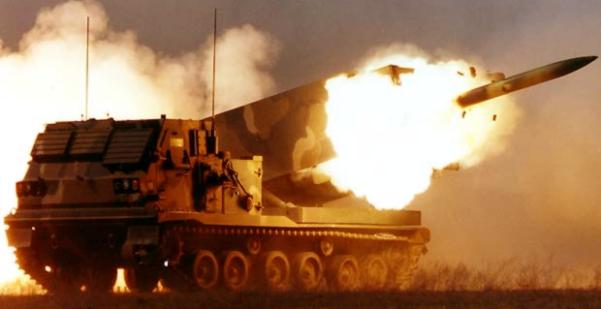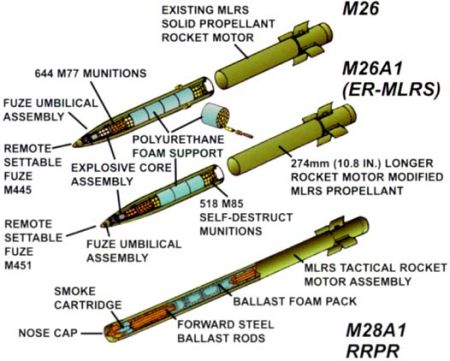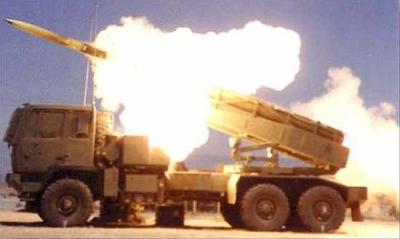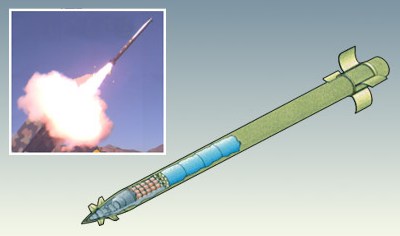Lockheed Martin (Vought) MLRS Rockets
(M26, M30, M31, M403, M404)
The MLRS (Multiple Launch Rocket System) is a mobile rocket launcher which can fire a variety of rockets from the MLRS Familiy of Munitions (MFOM) as well as the MGM-140 ATACMS guided missile family.
MLRS started life as the U.S. Army's GSRS (General Support Rocket System) program in the mid-1970s. In 1976, Concept Definition Study contracts were let to several companies, and in 1977, Vought and Boeing were selected for competitive development. In December 1979, GSRS was renamed as MLRS, and May 1980, Vought was announced as prime contractor for further development and production of the MLRS launcher and rockets. MLRS reached initial operational capability with the U.S. Army in 1983.
MLRS Launchers
The original MLRS launcher is the M270, also known as the SPLL (Self-Propelled Loader/Launcher). The M270 is a tracked vehicle, whose major components are the FCS (Fire Control System) and two launch boxes which can house six MFOM rockets or one ATACMS missile each. Beginning around 1995, an improved M270A1 SPLL was developed, and the operational test phase was conducted in 1999. The M270A1 has an improved fire control system (IFCS) with more modern electronics, and the ILMS (Improved Launcher Mechanical System) which provides for faster loading and aiming of the rocket launchers. Existing M270 units will be converted to M270A1 standard.
Another launcher for the MLRS rockets is the M142 HIMARS (High Mobility Artillery Rocket System), a wheeled vehicle with a single launch box (for six rockets or one ATACMS). The XM142 HIMARS Advanced Concept Technology Demonstration program started in 1996, and the EMD (Engineering and Manufacturing Development) phase, begun in January 2000, was successfully completed in September 2002. In April 2003, Lockheed Martin received the first HIMARS LRIP (Low-Rate Initial Production) contract, and the first operational HIMARS unit was fielded in 2005. HIMARS uses the same IFCS and ILMS components as the M270A1.
Basic MLRS Rocket, M26
The first MLRS rocket was the unguided M26 rocket. The M26 is spin-stabilized by 4 fins, has a range of 32 km (20 miles) and is armed with 644 M77 DPICM (Dual-Purpose Improved Conventional Munitions) anti-personnel/anti-materiel grenades. The M77 submunitions are dispensed over the target in mid-air, are drag-ribbon stabilized during free fall, and detonate on impact. The MLRS/M26 was first used operationally during Operation Desert Storm in 1991, where it acquired the nickname "steel rain".
 |
| Photo: Lockheed Martin |
| M26 MLRS Rocket (M270 launcher) |
The Extended Range MLRS Rocket (ER-MLRS) is a derivative of the M26 with a longer motor and only 518 grenades. This improves the range to more than 45 km (28 miles). The first ER-MLRS rocket was planned to be the M26A1, which uses improved M85 DPICM submunitions. The original M77 has a relatively high dud rate (about 5%), and the M85 is a derivative with a self-destruct fuze to lower this rate significantly (< 1%). However, the development of the XM85 progressed slower than expected, and therefore the initial ER-MLRS rockets (first production contract was awarded in July 1996) were armed with M77 bomblets. The M77-equipped ER-MLRS is designated M26A2. By 1999, the M85 grenade was ready for production, and the final 1200 of a total of about 4300 ER-MLRS rockets for the U.S. Army were built as M26A1.
 |
| Image: Lockheed Martin |
| M26, M26A1, M28A1 MLRS Rockets |
MLRS Practice Rocket, M28
The M28 is a training version of the M26, which replaces the warhead with steel ballast and three smoke canisters. The M28A1 RRPR (Reduced Range Practice Rocket) is a derivative of the M28 with a blunt high-drag nose. This reduces the rocket's maximum range to 15 km (9 miles), making it suitable for use on smaller firing ranges.
 |
| Photo: via GlobalSecurity.org |
| M28 MLRS Practice Rocket (XM142 launcher) |
Other MLRS Munitions (M27, M29, XM135)
The M27 Trainer LP/C (Launch Pod/Container) is a completely inert electronic device to simulate a full load and launch sequence. The XM29 was a rocket with SADARM (Sense and Destroy Armor) submunitions, while the XM135 Binary Chemical Capability munition was intended for retaliatory chemical warfare. The XM135 contained two non-lethal agents, which were mixed after launch to form the deadly VX nerve agent. The XM29 and XM135 were developed in the late 1980s/early 1990s, but were apparently not procured for regular field use.
Guided MLRS Rocket, M30/M31
In 1994, the U.S. Army initiated the GMLRS (Guided MLRS) ATD (Advanced Technology Demonstration) program to develop a guided derivative of the M26 MLRS rocket. The M30 GLMRS rocket uses a guidance system with an IMU (Inertial Measurement Unit) and a GPS receiver, and has four small additional control fins in the nose. To make full use of the much improved accuracy of the weapon over long distances, only 404 M85 DPICM bomblets are carried for a range of more than 60 km (37 miles). Minimum effective range for the GMLRS is about 10 km (6 miles). The first fully guided test launch of an XM30 occurred in May 1998.
 |
| Photo: Lockheed Martin |
| XM30 GMLRS Rocket |
In late 1998, the GMLRS program entered a four-year SDD (Systems Development and Demonstration) phase, and the final production qualification tests were successfully completed in December 2002. In March 2003, the M30 GMLRS rocket was approved for low-rate initial production, and operational testing was completed in December 2004.
The production run of the M30 missile was short-lived, because the dud rate of the M85 DPICM bomblets could not be brought below 1%. It was replaced by the M30A1, which began development in 2008 and entered full-rate production in 2015. The M30A1 is equipped with the so-called Alternative Warhead (AW), which consists of 182000 pre-formed tungsten fragments, for area effects without the risk of unexploded ordnance. The current production variant of the M30 is the M30A2, which features an Insensitive Munition Propulsion System (IMPS). The M31 GMLRS missile is externally identical to the M30, but is armed with a 90 kg (200 lb) unitary high-explosive blast-fragmentation warhead. It entered production in 2005. The M31A1 has an improved fuzing system with an airburst option, and the current M31A2 adds the same IMPS motor as the M30A2. By the end of 2021, more than 50000 GMLRS rounds of all types had been delivered, and production is continuing at a rate of about 9000 per year.
Extended Range Guided MLRS Rocket, M403/M404
Around 2020, Lockheed Martin began the development of an extended range version of the M30/M31 GMLRS missiles, labeled ER-GMLRS. The first flight of an ER-GMLRS missile occurred in March 2021, and development testing was completed by the end of 2023. The ER-GMLRS has a slightly bigger rocket motor, a redesigned fuselage, and tail-control surfaces. The range is increased to 150 km (93 miles), and it's compatible with the same launchers as MLRS and GMLRS. Like GMLRS, the ER-GMLRS missile comes in two warhead variants - the XM403 rocket has the same Alternative Warhead as the M30A2, while the XM404 has the unitary warhead of the M31A2.
 |
| Image: Lockheed Martin |
| ER-GMLRS Rocket |
Designation Note:
The official nomenclature for the MLRS munitions is "Rocket Pod, 298 mm", and the numbers M26 through M31 do not fall into the Army's "Rocket" series (e.g. the Rocket M26 was a 2.36-in chemical warfare rocket).
Specifications
Note: Data given by several sources show slight variations. Figures given below may therefore be inaccurate!
Data for M26, M26A1, M26A2, M30, M30A2, M31A2:
| M26 | M26A1 | M26A2 | M30 | M30A2 | M31A2 | |
|---|---|---|---|---|---|---|
| Length | 3.94 m (12 ft 11 in) | |||||
| Diameter | 22.7 cm (8.94 in) | |||||
| Weight | 306 kg (675 lb) | 296 kg (650 lb) | ca. 300 kg (660 lb) | |||
| Range | 32 km (20 miles) | > 45 km (28 miles) | > 60 km (37 miles) | |||
| Propulsion | Solid-fueled rocket | |||||
| Warhead | 644 M77 DPICM bomblets | 518 M85 DPICM bomblets | 518 M77 DPICM bomblets | 404 M85 DPICM bomblets | Tungsten fragments | 90 kg (200 lb) HE |
Main Sources
[1] R.T. Pretty (ed.): "Jane's Weapon Systems 1982-83", Jane's, 1983
[2] Lockheed Martin
Missiles and Fire Control Website
[3] Wikipedia: M270 Multiple Launch Rocket System
Back to Directory of U.S. Military Rockets and Missiles, Appendix 4
Last Updated: 14 April 2024